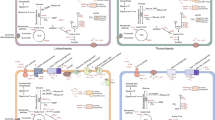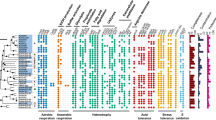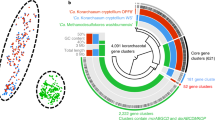Abstract
Recent genetic studies have elucidated that carbonic anhydrase (CA; EC 4.2.1.1), a ubiquitous enzyme catalyzing interconversion between CO2 and bicarbonate, is essential for microbial growth under ambient air but not under high-CO2 air. The irregular distribution of the phylogenetically distinct types of CA in the prokaryotic genome suggests its complex evolutionary history in prokaryotes. This paper deals with the genetic defect of CA in Symbiobacterium thermophilum, a syntrophic bacterium that effectively grows on CO2 generated by other bacteria. Phylogenetic analysis based on 31 ribosomal protein sequences demonstrated the affiliation of Symbiobacterium with the class Clostridia with 100% bootstrap support. The phylogeny of β- and γ-type CA distributed among Clostridia supported the view that S. thermophilum and several related organisms lost this enzyme during the course of evolution. The loss of CA could be based on the availability of a high level of CO2 in their living environments.


Similar content being viewed by others
References
Aguilera J, Van Dijken JP, De Winde JH, Pronk JT (2005) Carbonic anhydrase (Nce 103p): an essential biosynthetic enzyme for growth of Saccharomyces cerevisiae at atmospheric carbon dioxide pressure. Biochem J 391:311–316
Gao B, Gupta RS (2005) Conserved indels in protein sequences that are characteristic of the phylum Actinobacteria. Int J Syst Evol Microbiol 55:2401–2412
Hashimoto M, Kato J (2003) Indispensability of the Escherichia coli carbonic anhydrases YadF and CynT in cell proliferation at a low CO2 partial pressure. Biosci Biotechnol Biochem 67:919–922
Hippe H, Andreesen JR, Gottschalk G (1992) The genus Clostridium—nonmedical. In: Balows A, Trueper HG, Dworkin M, Harder W, Scheleifer K-H (eds) The procaryotes, a handbook on the biology of bacteria: ecophysiology, isolation, identification, applications, 2nd edn. Springer, New York, pp 1800–1866
Kanehisa M, Goto S, Hattori M, Aoki-Kinoshita KF, Itoh M, Kawashima S, Katayama T, Araki M, Hirakawa M (2006) From genomics to chemical genomics: new developments in KEGG. Nucleic Acids Res 34:D354–D357
Kusian B, Sultemeyer D, Bowien B (2002) Carbonic anhydrase is essential for growth of Ralstonia eutropha at ambient CO2 concentrations. J Bacteriol 184:5018–5026
Lane TW, Saito MA, George GN, Pickering IJ, Prince RC, Morel FM (2005) A cadmium enzyme from a marine diatom. Nature 435:42
Merlin C, Masters M, McAteer S, Coulson A (2003) Why is carbonic anhydrase essential to Escherichia coli? J Bacteriol 185:6415–6424
Mitsuhashi S, Ohnishi J, Hayashi M, Ikeda M (2004) A gene homologous to beta-type carbonic anhydrase is essential for the growth of Corynebacterium glutamicum under atmospheric conditions. Appl Microbiol Biotechnol 63:592–601
Ohno M, Okano I, Watsuji T, Kakinuma T, Ueda K, Beppu T (1999) Establishing the independent culture of a strictly symbiotic bacterium Symbiobacterium thermophilum from its supporting Bacillus strain. Biosci Biotechnol Biochem 63:1083–1090
Ohno M, Shiratori H, Park MJ, Saitoh Y, Kumon Y, Yamashita N, Hirata A, Nishida H, Ueda K, Beppu T (2000) Symbiobacterium thermophilum gen. nov., sp. nov., a symbiotic thermophile that depends on co-culture with a Bacillus strain for growth. Int J Syst Evol Microbiol 50:1829–1832
Oshima K, Nishida H (2007) Phylogenetic relationships among mycoplasmas based on the whole genomic information. J Mol Evol 65:249–258
Pridmore RD, Berger B, Desiere F, Vilanova D, Barretto C, Pittet AC, Zwahlen MC, Rouvet M, Altermann E, Barrangou R, Mollet B, Mercenier A, Klaenhammer T, Arigoni F, Schell MA (2004) The genome sequence of the probiotic intestinal bacterium Lactobacillus johnsonii NCC 533. Proc Natl Acad Sci USA 101:2512–2517
Shigenobu S, Watanabe H, Hattori M, Sakaki Y, Ishikawa H (2000) Genome sequence of the endocellular bacterial symbiont of aphids Buchnera sp. APS. Nature 407:81–86
Smith KS, Ferry JG (2000) Prokaryotic carbonic anhydrases. FEMS Microbiol Rev 24:335–366
Sugihara T, Watsuji TO, Kubota S, Yamada K, Oka K, Watanabe K, Meguro M, Sawada E, Yoshihara K, Ueda K, Beppu T (2008) Distribution of Symbiobacterium thermophilum and related bacteria in the marine environment. Biosci Biotechnol Biochem 72:204–211
Suzuki S, Horinouchi S, Beppu T (1988) Growth of a tryptophanase-producing thermophile, Symbiobacterium thermophilum gen. nov., sp. nov., is dependent on co-culture with a Bacillus sp. J Gen Microbiol 134:2353–2362
Tamura K, Dudley J, Nei M, Kumar S (2007) MEGA4: molecular evolutionary genetics analysis (MEGA) software version 4.0. Mol Biol Evol 24:1596–1599
Thompson JD, Higgins DG, Gibson TJ (1994) CLUSTAL W: improving the sensitivity of progressive multiple sequence alignment through sequence weighting, position-specific gap penalties and weight matrix choice. Nucleic Acids Res 22:4673–4680
Ueda K, Beppu T (2007) Lessons from studies of Symbiobacterium thermophilum, a unique syntrophic bacterium. Biosci Biotechnol Biochem 71:1115–1121
Ueda K, Ohno M, Yamamoto K, Nara H, Mori Y, Shimada M, Hayashi M, Oida H, Terashima Y, Nagata M, Beppu T (2001) Distribution and diversity of symbiotic thermophiles, Symbiobacterium thermophilum and related bacteria, in natural environments. Appl Environ Microbiol 67:3779–3784
Ueda K, Tagami Y, Kamihara Y, Shiratori H, Takano H, Beppu T (2008) Isolation of bacteria whose growth is dependent on high levels of CO2 and implications of their potential diversity. Appl Environ Microbiol 74:4535–4538
Ueda K, Yamashita A, Ishikawa J, Shimada M, Watsuji T, Morimura K, Ikeda H, Hattori M, Beppu T (2004) Genome sequence of Symbiobacterium thermophilum, an uncultivable bacterium that depends on microbial commensalism. Nucleic Acids Res 32:4937–4944
Watsuji T-O, Kato T, Ueda K, Beppu T (2006) CO2 supply induces the growth of Symbiobacterium thermophilus, a syntrophic bacterium. Biosci Biotechnol Biochem 70:753–756
Zhao Y, Davis RE, Lee IM (2005) Phylogenetic positions of ‘Candidatus Phytoplasma asteris’ and Spiroplasma kunkelii as inferred from multiple sets of concatenated core housekeeping proteins. Int J Syst Evol Microbiol 55:2131–2141
Acknowledgments
This study was supported by the High-Tech Research Center Project of the Ministry of Education, Culture, Sports, Science and Technology, Japan.
Author information
Authors and Affiliations
Corresponding author
Electronic supplementary material
Below is the link to the electronic supplementary material.
Below is the link to the electronic supplementary material.
Rights and permissions
About this article
Cite this article
Nishida, H., Beppu, T. & Ueda, K. Symbiobacterium Lost Carbonic Anhydrase in the Course of Evolution. J Mol Evol 68, 90–96 (2009). https://doi.org/10.1007/s00239-008-9191-4
Received:
Revised:
Accepted:
Published:
Issue Date:
DOI: https://doi.org/10.1007/s00239-008-9191-4




